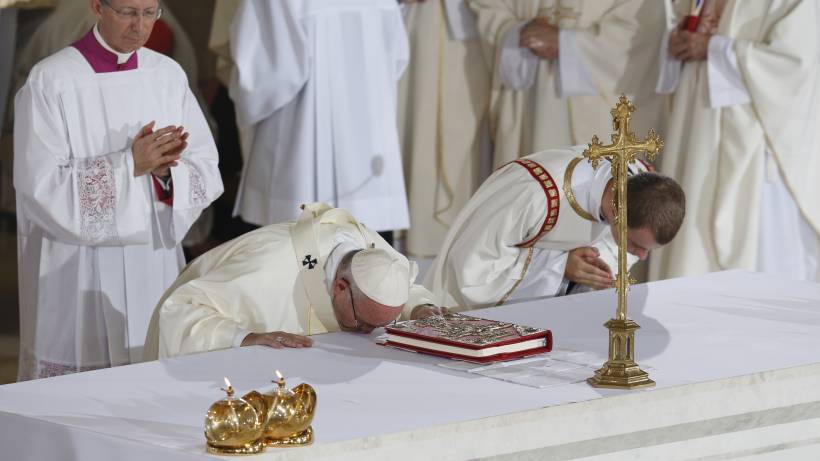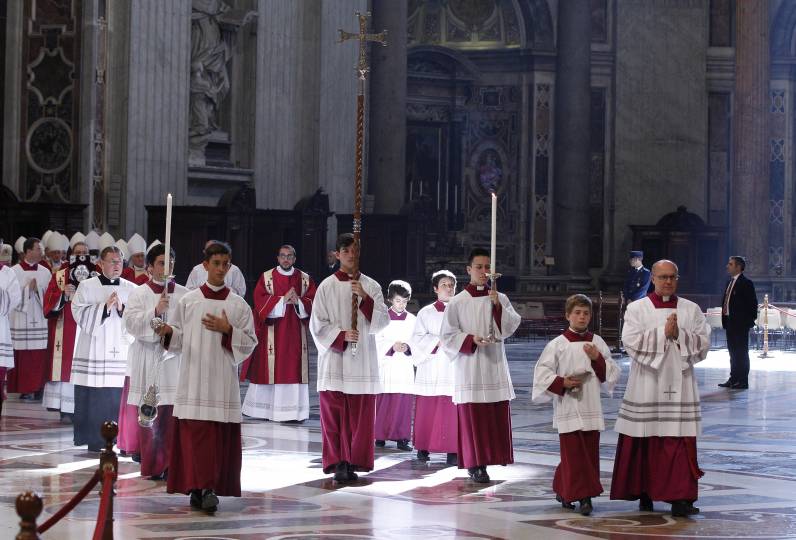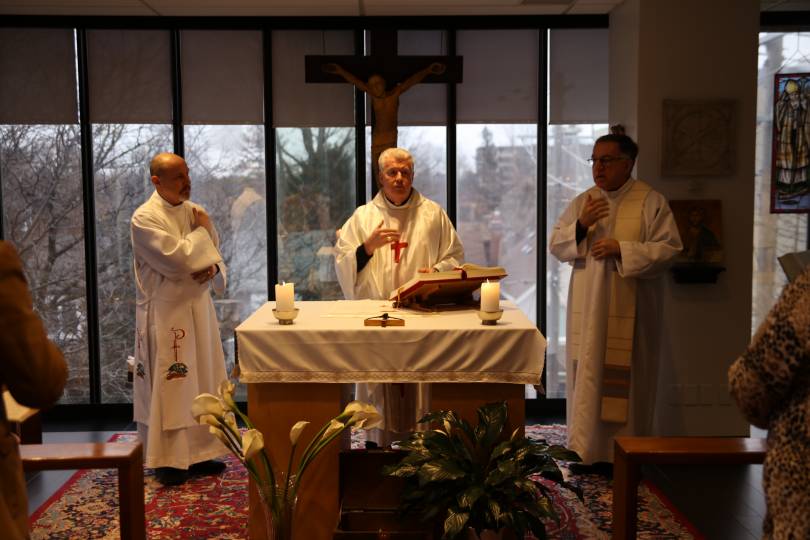



Deacon-structing the Mass | Part 2: The Entrance
Deacon Pedro
Sunday, August 19, 2018

CNS/Paul Haring
Last week we learned that it is our right to fully, actively, and consciously participate in the Mass. How can we do that if we don’t know what everything means? Over the next couple of weeks I hope that we can explain every part of the Mass in order to help you enter more deeply into the Mystery of the celebration.
To review: The Mass has two parts: the Liturgy of the Word and the Liturgy of the Eucharist. There are also Introductory Rites and Concluding Rites.
 The candles can also be the candles that are placed at the side of or on the altar, or if there are already altar candles, they can be put in a separate space and be used as the candles for the Gospel Procession (there are no candles in the Concluding Procession). If there are no acolytes, it's only necessary to have someone carrying the Cross; no candles are necessary in the procession.
The Procession is much more than just a practical way to "get Father into the sanctuary". Remember that the Priest is a symbol of Christ. In the Opening Procession we are welcoming Jesus himself as He enters in procession (remember Palm Sunday) into our midst. We welcome Him with a song of praise. In this post, Mons. Charles Pope of the Archdiocese of Washington explains it well and offers some historical perspective.
The candles can also be the candles that are placed at the side of or on the altar, or if there are already altar candles, they can be put in a separate space and be used as the candles for the Gospel Procession (there are no candles in the Concluding Procession). If there are no acolytes, it's only necessary to have someone carrying the Cross; no candles are necessary in the procession.
The Procession is much more than just a practical way to "get Father into the sanctuary". Remember that the Priest is a symbol of Christ. In the Opening Procession we are welcoming Jesus himself as He enters in procession (remember Palm Sunday) into our midst. We welcome Him with a song of praise. In this post, Mons. Charles Pope of the Archdiocese of Washington explains it well and offers some historical perspective.

 Every week, Deacon Pedro takes a particular topic apart, not so much to explore or explain the subject to its fullness, but rather to provide insights that will deepen our understanding of the subject. And don’t worry, at the end of the day he always puts the pieces back together. There are no limits to deaconstructing: Write to him and ask any questions about the faith or Church teaching: [email protected]
Every week, Deacon Pedro takes a particular topic apart, not so much to explore or explain the subject to its fullness, but rather to provide insights that will deepen our understanding of the subject. And don’t worry, at the end of the day he always puts the pieces back together. There are no limits to deaconstructing: Write to him and ask any questions about the faith or Church teaching: [email protected]
The Mass begins with the Introductory Rites.
Their purpose is to help us gather and prepare. It includes everything that takes place before the First Reading. The Congregation stands during this whole first section of the Mass. We stand together as a sign of unity.The Entrance
The formal beginning of the Mass is the entrance of the ministers. Even if for some reason the ministers do not enter in a major procession from the back of the Church (the building is too small, for example), there should be a formal entrance. This entrance is accompanied by a song.Why do we sing?
Our singing opens us to the action of the Holy Spirit. The General Instruction of the Roman Missal (GIRM) notes that song is a way of showing and intensifying our unity with one another. That’s why we should all be singing together. In order to achieve this, the Entrance Song must be a piece that can be sung by all. A beautiful choir singing Gregorian Chant or a gorgeous classical piece in six-part harmony is not a good opening hymn - not unless the whole congregation can (and does) sing it!This is what we mean by "congregational" music.
While singing together helps us gather and brings us together and helps us begin to enter into the spirit of the celebration, the main purpose of the Opening Hymn is to accompany the entrance procession. It is not a performance and should not continue much after the procession has ended. (Although continued singing can strengthen the effect of a well chosen and executed piece, it can also be deadly if it’s not a well-chosen piece or if it continues for too long!) The general rule is that once the ministers arrive at their seats, the Opening Song should soon be coming to its end. The song should have something to do with gathering or coming together. It can also be chosen keeping in mind the theme of the day. The Entrance Antiphon in the Roman Missal might inspire the choice of a piece connected with the heart of the liturgy of the day. If there is no singing, the Entrance Antiphon for the day may be read by a minister/lector or by the full congregation in unison. It could also be read by the Presider as part of the Greeting.The Procession
In order to celebrate Mass a Crucifix needs to be present, known as the Altar Cross, and at least two candles. These are the main ornaments of the altar. The entrance procession is led by an Acolyte (altar server; could be anyone if there are no servers) carrying a Processional Cross (also a crucifix). It could be the same Cross. If so, it remains in the Sanctuary (by or on the altar) during the whole celebration (if there isn’t one already). Most parishes have the Altar Cross already on the altar. If this is the case, the Processional Cross is placed out of the sanctuary, in an appropriate place, until the Concluding Procession. There should only be one crucifix in the Sanctuary during Mass. In the procession, the Cross is accompanied by the acolytes carrying two candles (on either side), then followed by the lectors and/or ministers of the Eucharist, the deacon carrying the Book of the Gospels (if there is no deacon, a lector may carry it), followed by the Presider. If there is no Book of the Gospels, the deacon enters at the side of the Presider (not in front or behind!). If there are other priest-con-celebrants, they go in front of the Presider and the deacon. If there's a bishop, the deacon also enters at the side of the bishop. If there is incense, the Thurifer (or minister carrying the incense), carrying the Thurible (the censer), goes in front of the Processional Cross.
CNS/Paul Haring
Reverence to the Altar
The focal point in all Catholic Churches is the altar. It has a function but it is also a symbol of Christ. All altars are anointed with Holy Chrism (a special oil used for Baptism, Confirmation, and Ordinations) when churches are consecrated. All altars should also contain a relic (see GIRM #302 and Canon 1237) – usually of the patron saint of the parish. This custom dates back to the time when Mass was celebrated in the catacombs – literally with the bones of the saints! Having a relic in the altar is a reminder that when we celebrate Mass, we do so together with the Communion of Saints. If your parish altar doesn't have a relic, it's likely that none could be acquired. But there should be one. When we enter a church, we reverence the altar with a profound bow. (We reverence the Tabernacle with a genuflection.) The ministers and acolytes who enter in the Opening Procession reverence the altar with a profound bow. (Ministers carrying things, like the cross, the candles, or a book, do not bow as that is just awkward and looks clumsy.) The priest and deacon also kiss the altar upon their entry because it is a symbol of Christ. On special occasions the altar is incensed. When we see the priest and the deacon genuflect, they do so towards the Tabernacle. The gesture towards the altar is a bow and then the kiss. In my parish, since the Tabernacle is behind the altar, it looks like we are bowing and genuflecting in front of the altar, but these are two separate gestures. Still, there is no need to do both. It is appropriate to merely do one or the other (no matter where the Tabernacle is), towards (in front of) the altar.Greeting of the Assembled People
The priest who "celebrates" the Mass is called the Presider. Technically, all the faithful celebrate the Mass, so it is not correct to say that the priest celebrates the Mass (even though it is common usage and even I have already used the expressions “priest celebrant” and “celebrating priest”).The priest presides at the Mass because he is the “president” of the celebration.
The presider arrives at the chair and begins with the Sign of the Cross. We begin all our Catholic celebrations with the Sign of the Cross. With it we proclaim together the mystery of the Cross of Christ, we are reminded of our Baptism, and we are drawn into the life of the Trinity. We begin everything with the Sign of the Cross because the Cross is the sign of Love - of the Trinity.
Salt + Light
We should make the Sign of the Cross always keeping all of this in mind.
The Processional or Altar Cross, is also a reminder of all of this. The Presider will then say, the greeting, “The Lord be with you.” This “hello” is modeled on Christ’s greeting to his disciples after the resurrection: “Peace be with you.” (John 20:19). Longer greetings taken from the letters of St. Paul may also be chosen. (“May the Grace of our Lord Jesus Christ, the love of the Father and the fellowship of the Holy Spirit, be with you” from 2 Corinthians 13:14, for example). The response is “and with your spirit,” which is also scriptural (see Gal 6:18; Phil 4:23; Philemon 25; 2 Tim 4:22). The General Instruction points out:“By this greeting and the people’s response, the mystery of the Church gathered together is made manifest.”After the greeting, the Presider may say a few words of welcome, but these should be succinct and well-prepared in advance. It could be to welcome visitors to the Parish during the summer months or to explain a special Feast that may be taking place. They need not and should not be related exclusively to the Liturgy of the Word but rather to the whole liturgy of day. While these words are not necessary, I would say that they are more than appropriate. I always appreciate it when, right off the bat, we get a sense that the priest is truly present to the Congregation and not just following rubrics and reading from a book. It's also nice to see the priest smile. My suggestion is for the priest to say a few words that are personal or specific to the Congregation, to welcome and to introduce the theme of the day. It also helps focus the congregation on a particular message they should be paying attention to on that particular day. Come back next week so we can continue with the Introductory Rites. And feel free to ask questions. Maybe I didn't explain something well enough or maybe I left something out (maybe I got something wrong!). Send me an email: [email protected].
Most of the information used in these blog posts comes from the text of a video made by Salt + Light Television in partnership with the National Liturgy Office of the Canadian Conference of Catholic Bishops in 2011 to help explain the latest changes to the language of the English Roman Missal, titled, THE CELEBRATION OF EUCHARIST for the Twenty-First Century. The project was headed by Fr. Bill Burke, and the text of that video was written by Canadian liturgist Margaret Bick, both of whom I owe a great deal of thanks for the vast knowledge they shared with us.
 Every week, Deacon Pedro takes a particular topic apart, not so much to explore or explain the subject to its fullness, but rather to provide insights that will deepen our understanding of the subject. And don’t worry, at the end of the day he always puts the pieces back together. There are no limits to deaconstructing: Write to him and ask any questions about the faith or Church teaching: [email protected]
Every week, Deacon Pedro takes a particular topic apart, not so much to explore or explain the subject to its fullness, but rather to provide insights that will deepen our understanding of the subject. And don’t worry, at the end of the day he always puts the pieces back together. There are no limits to deaconstructing: Write to him and ask any questions about the faith or Church teaching: [email protected]Related Articles:
<<
SUPPORT LABEL
$50
$100
$150
$250
OTHER AMOUNT
DONATE
Receive our newsletters
Stay Connected
Receive our newsletters

Stay Connected







